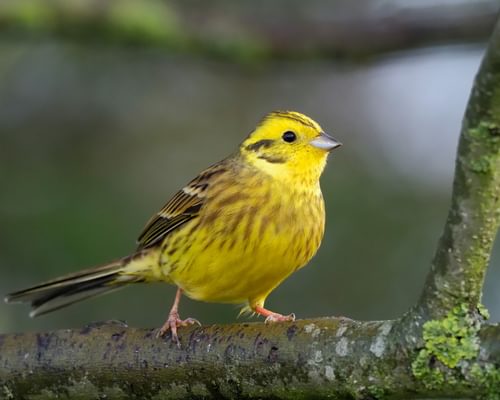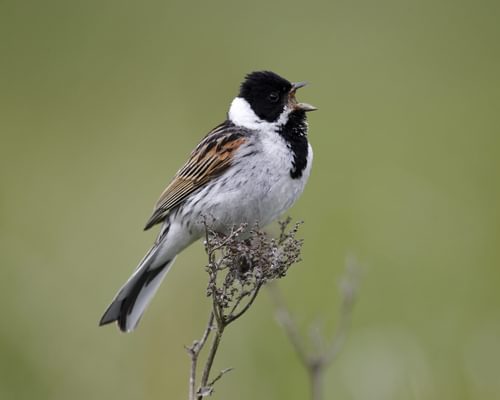Cirl Bunting
Least ConcernEmberiza cirlus
Visual Identification
Appearance
The Cirl Bunting is a small, colourful bird with a distinctive appearance. Males have a bright yellow head with a black crown, eye stripe, and chin. Their back is chestnut-brown, contrasting with an olive-green rump and yellow underparts.
Females, with a brown-streaked body and a yellowish wing bar, aren't as colourful as males. Both sexes have a grey bill and pink legs. Juveniles resemble females but with heavier streaking.
Size
Length
15cm to 16.5cm
Wingspan
22cm to 25cm
Weight
20g to 25g
Habitat and Distribution
Habitats
Woodland
Garden
Wetland
Coastal
Urban
Farmland
Grassland
Desert
Tundra
Rainforest
Mountain
Savanna
Distribution
Cirl Buntings are found in southern Europe, from Portugal to Greece, and parts of North Africa. They prefer warm, dry climates with open farmland, hedgerows, and scattered trees.
In the UK, their range is restricted to coastal areas of Devon and Cornwall, with some reintroduced populations in other southern counties. They are generally sedentary, with only short-distance movements in winter.
Elevation Range
Up to 1,000 meters
Climate zones
Temperate, Mediterranean
Distribution Map
This map gives you a rough idea of where you might spot a Cirl Bunting. The coloured areas show countries where these birds have been seen.
A few things to keep in mind:
- Birds might not be everywhere in the coloured areas, for example, they may be present around the coast of that country
- Where birds live can change with seasons and available food
- This map is quite simple - it doesn't show exact locations
We're working on making our maps even better! Soon, we hope to show you:
- More detailed maps for bigger countries, including state and region
- How birds move around during different seasons
Distribution by Region
Behaviour and Ecology
Bird Attributes
This feature is in beta. We'd love your feedback to improve it!
Share your thoughtsBird Attributes Explained
Our bird attributes system rates various aspects of a bird's capabilities on a scale of 0-100, based on data from field observations, scientific studies, and expert knowledge.
Attribute Categories:
- Agility: Manoeuvrability, speed, and grace in flight or movement.
- Strength: Physical power, often correlating with size and hunting abilities.
- Adaptability: Ability to thrive in various environments or changing conditions.
- Aggressiveness: Territorial behaviour and assertiveness, particularly during breeding seasons.
- Endurance: Stamina, often seen in migration patterns or foraging behaviours.
Understanding the Ratings:
- 0-20: Very Low
- 21-40: Low
- 41-60: Average
- 61-80: High
- 81-100: Very High
Remember, these attributes are relative to other bird species and don't necessarily indicate superiority.
Hover over the icon next to each attribute for more information.
Tap the icon next to each attribute for more information.
Agility
Reflects the bird's manoeuvrability, speed, and grace in flight or movement.
The Cirl Bunting displays moderate agility, evident in its quick, jerky hops whilst foraging and its ability to navigate hedgerows and low trees. Its aerial displays during breeding season also suggest a fair degree of manoeuvrability.
Strength
Indicates the bird's physical power, often correlating with size and hunting abilities.
As a small songbird weighing only 20-25 grams, the Cirl Bunting possesses limited strength. Its diet of insects, seeds, and small invertebrates doesn't require significant physical power.
Adaptability
Represents the bird's ability to thrive in various environments or changing conditions.
The Cirl Bunting demonstrates good adaptability, particularly in its seasonal diet shift from insects in summer to seeds in winter. Its ability to thrive in mixed farmland environments and its successful response to conservation efforts also indicate adaptability.
Aggressiveness
Measures the bird's territorial behaviour and assertiveness, particularly during breeding seasons.
While not overtly aggressive, male Cirl Buntings do exhibit territorial behaviour during breeding season, engaging in aerial displays and defending their chosen areas. However, they are not known for exceptional aggression compared to other bird species.
Endurance
Reflects the bird's stamina, often seen in migration patterns or foraging behaviours.
The Cirl Bunting shows moderate endurance. As a partially migratory species capable of short-distance movements, it possesses some stamina. Its ability to raise multiple broods in a season (up to three) also suggests a fair level of endurance, though it's not known for exceptional long-distance flights or extreme physical feats.
Diet
Cirl Buntings have a varied diet that changes seasonally. In summer, they primarily feed on insects and spiders, which are crucial for raising chicks. Grasshoppers and locusts are two of the most common prey items.
During winter, they switch to seeds from grasses and cereals, foraging in stubble fields and weedy areas.
Behaviour
Cirl Buntings are often seen perched on top of hedges or low trees, singing their distinctive song. They forage on the ground in small groups, moving with quick, jerky hops.
During the breeding season, males become territorial and engage in aerial displays to attract mates.
Vocalisation
The Cirl Bunting's song is a distinctive, rattling trill often described as 'zizi-zizi-zizi', giving rise to its alternative name. Males sing from prominent perches, especially during the breeding season. Their call is a soft 'tsip' or 'zit', often given in flight.
Their songs are loud, and can often be heard up to half a kilometre away.
Nesting & Breeding
Cirl Buntings breed from late April to August. Males establish territories and attract females with their distinctive song and display flights.
Nests are built low in dense vegetation, often in hedges or gorse bushes. Females construct a cup-shaped nest of grass and moss lined with fine roots and hair. They typically lay 3-4 eggs, which are pale blue or grey with dark markings.
Incubation lasts about 12-13 days and is carried out solely by the female. Both parents feed the chicks, which fledge after 12-13 days. Pairs often raise two or three broods per season.
Lifespan
The Cirl Bunting typically lives for 2 to 3 years, with a maximum recorded lifespan of 6.1 years.
Like all birds, lifespan can be affected by factors including predation, habitat quality, disease, and access to food sources.
Conservation and Status
Global Conservation Status
Once widespread in southern England, Cirl Buntings experienced a severe decline in the 20th century.
Conservation efforts, including targeted agri-environment schemes, have helped stabilise and increase their population in recent years, particularly in Devon.
Birdwatching Tips
- Look for Cirl Buntings in hedgerows and field margins in southern England, especially Devon and Cornwall.
- Listen for their distinctive 'zizi' call, which gives them their alternative name.
- Observe feeding areas near mixed farmland with cereal crops and grassland.
- Visit known breeding sites in spring and summer for the best chance of sightings.
- In size and basic appearance resembling a finch but with a longer tail, the male can often be seen singing from the tops of bushes or heard vocalising amongst the trees, requiring patience and an eagle’s eye to spot!
Additional Information
Quick Facts
Other names:
Zizi Bunting
Family:
EmberizidaePredators
Did You Know?
- Cirl Buntings are the UK's rarest resident bunting species.
- They were once common across southern England but declined by 97% between 1970 and 1989.
- Their recovery in Devon is considered one of the UK's most successful farmland bird conservation projects.
Was this bird profile helpful?
Your feedback helps us improve our content
Thanks for your feedback!
Your input helps us improve our content.
Community Experience
Community Ratings
No ratings yet - be the first to rate this bird!
Latest Community Reviews
No reviews yet
Sign in to be the first to review
Community Reviews
Create Your Free Account Welcome Back!
Join our community to rate birds and share your experiences. Creating an account is completely free and only takes a minute. Sign in to your account to rate birds and share your experiences with our community.
Your information is secure and will never be shared.
By creating an account, you agree to our Privacy Policy.
Similar Birds
References
- 2 3
website: BirdLife International. 2018. Emberiza cirlus. The IUCN Red List of Threatened Species 2018: e.T22720888A132004013.
View source - 4
report, 2015: EBCC
- 1
journalArticle, 2006: Moller, Sociality, age at first reproduction and senescence: comparative analyses of birds, J Evol Biol, 19:682-689
View source

